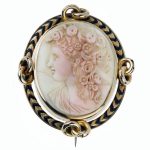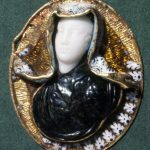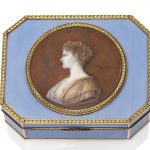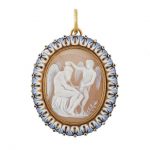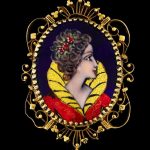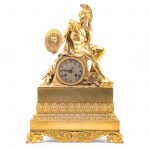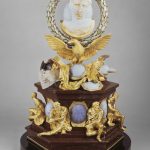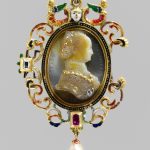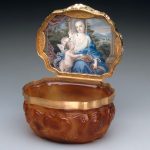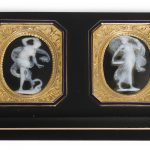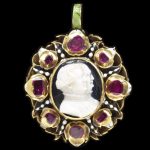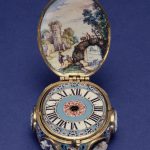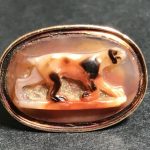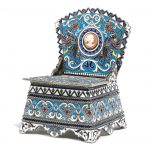Enamel Set Cameos. Enameling has been used for centuries and has often been used with cameos. The enamel used most often in jewellery and object d’art is vitreous of enamelling which is made by fusing powdered glass to a substrate by firing.
A shell cameo brooch Of oval design depicting a female bust with flowers adorning her hair, to a frame applied with arrow-shaped lines of black enamel and intertwined ring motifs, length approximately 50mm, width approximately 45mm
Sold for £125 inc. premium at Bonhams in 2017
16th century pendant cameo. Centre of pendant; gold oval plate with bust of lady in cameo in white and nearly black stone; white enamel on hood and borders.
Reference: © The Trustees of the British Museum
Antique Gold, Hardstone Cameo and Enamel Pendant Centering an oval cameo depicting the mythical characters Icarus and Daedalus, edged by fine rope-twist gold, within a frame of stylized petals applied with white and blue enamel, circa 1870. With box.
Cameo: nice carving, translucent. Some enamel loss on balls. Several chips on blue enamel. Overall good condition. 1 1/2 x 1 1/4″.
Sold for $3,125 (includes buyer’s premium)
One electronically tested 14KT yellow gold ladies cast & assembled cameo brooch/pendant. The brooch/pendant features a blue enamel cameo depicting the dextral profile of a woman wearing French Victorian clothing. The style of enamel is Limoges. The back of the brooch is signed “FRANCE”. Cameo area measurements are 34 x 27mm. The cameo is framed by a 14KT yellow gold patterned frame, completed by a horizontally placed pin and hidden 14K yellow gold bail. Brooch/pendant area measurements 50 x 35mm. Identified with markings of “14K”.
Sold for $950 at Seized Assets Auctioneers in 2018
French bronze dore figural mantel clock rectangular plinth base on scrolling foot, surmounted with a figure of Perseus holding shield with head of Medusa, incorporating a clock, dial with Roman numerals, 19 3/4 in. H., 13 1/4 in. W., 5 in. D.
Sold for $2,000 at Alex Cooper in 2017
In 1785, Luigi Valadier created a spectacular mounting for this no less exceptional cameo, carved in the 1st century AD with the likeness of the Roman emperor Augustus. Designed as a portable item of imperial propaganda, the bust is one of numerous portraits executed during Augustus’s reign (27 BC-AD 14), in pietre dure, marble, or in cameo form. The 18th-century mounting incorporates a number of antique elements: the eagle’s head, phalerae, and breastplate. A portrait of the emperor Augustus The cameo features an agate portrait bust of the emperor Augustus, dressed in the paludamentum or purple cloak of the commander-in-chief of the Roman army. Stylistically, the bust belongs to one of the principal types of carved portrait of Augustus (datable to c. 20 BC); it was probably carved during his lifetime at the beginning of the 1st century AD, and closely resembles a statue discovered at Livia’s villa in Prima Porta. The modeling of the emperor’s face conveys the same sense of energy; both works also include a similar hair arrangement, notably the distinctive part and cleft in the bangs over the left eye and temple.
Reference:The Louvre
Bona Sforza (1493–1557), Queen of Poland. Cameo by Giovanni Jacopo Caraglio (Italian, Parma or Verona ca. 1500/1505–1565 Krakow (?)) frame 19th century
Exceptionally for the Renaissance, this is a signed cameo, bearing the signature of Gian Giacomo Caraglio, who was born in Verona and later worked in Venice and then Cracow and who was best known as a printmaker. Bona Sforza, daughter of the duke of Milan, married Sigismund I, king of Poland, in 1518. At Sigismund’s death in 1548 she returned to Italy, where she died in 1557. The cameo is inlaid with gold that enhances details of Bona’s chain and hairnet, and a silver Medusa’s head (see detail; for Medusa, see also fig. 59) is inset on her breast, in the same spirit of jewelry within jewelry. The only other gem signed by Caraglio, an agate similarly bedecked with gold representing Barbara Radziwill, Bona’s successor as queen of Poland, is in the Münzkabinett, Munich. The dainty frame, although dated 1554 on the reverse, is a nineteenth-century invention.
Reference: The Metropolitan Museum of Art
Snuffbox German (probably Dresden) about 1760-1765 – Cartouche shaped. Top carved with cameo representation of Venus, Cupid & dolphin; shaped sides with baroque scrolled cartouches. Gold bezel on box and band on cover chased and set with enamel flowers on striated field; hinged across back & design partly on bezel. The underside of the hinged lid inset with a miniature painting of a woman and winged putto.
Reference: Museum of Fine Arts Boston
A gold-mounted tortoiseshell and cameo snuffbox, Pierre-André Montauban, Paris, 1798-1809 rectangular, the lid inset with two oval onyx cameos, one carved with Eurydice in swirling garments bitten by the serpent, after Giovanni Pichler, the other with the vestal virgin Tuccia with her sieve, after Luigi Pichler, each in a rectangular gold spandrel with cut corners, chased with leaf motifs, within dark blue enamel borders, gold mounts and lining, maker’s mark, bear’s head 3e titre and 3e Paris titre et garantie 1798-1809 8.9cm., 3 1/2 in. long
Sold for 10,000 GBP at Sothebys in 2018
Locket of a layered agate cameo of two male busts, set in gold decorated with painted enamels and rubies. Made in Germany (the cameo made about 1570, the setting about 1600). On the reverse a painted enamel landscape with a skull and a putto blowing bubbles (an allegory of the brevity of life). A memento mori or memorial locket.
Reference: © Victoria and Albert Museum
Enameled Watch with Cameos
Although the earliest enamel watches came from Blois, France, the German city of Augsburg had long been a center of clock and watch making. This is one of the earliest examples of a painted-enamel watch made in Germany. It is set with eight cameos and thirteen rubies. The agate cameos are contemporary (not antique gems), but they still advertise the patron’s sophisticated taste for the antique style. The inside covers depict landscapes with ancient ruins and pastoral scenes, reflecting another aspect of the classicizing taste of the time.
Johan Ferdinand Mehrer (Clockmaker) German (Artist) 1640-1650
Reference: The Walter Art Museum
